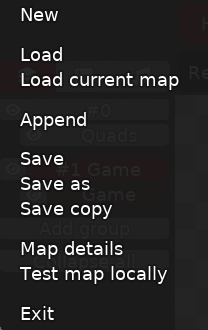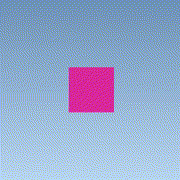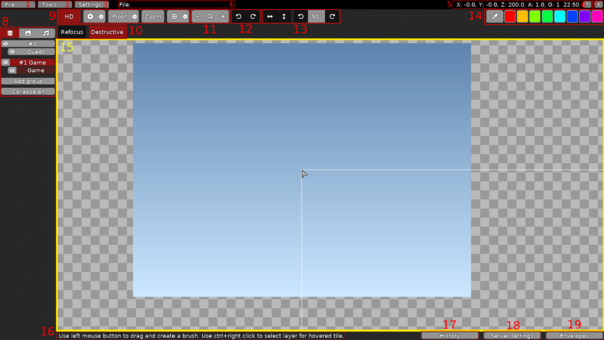Harita oluşturma
Beyin fırtınası kısmı, harita yapımcısının hayal gücüyle yaratıcı ve eğlenceli bir harita yapmasını gerektirir.
Haritalama kısmı, harita yapımcısının haritaya güzel bir görünüm katmasını gerektirir, tasarım aşamasında ortaya insanları memnun edecek bir iş koymalıdır ve her harita oluşturmada temsil edilen bilgiler yeterince açık olmalı ve belirsiz olmamalıdır, ayrıca genel tasarım stili de genellikle oyunun sanat tarzına uygun olmalıdır.
Harita testi kısmı, mevcut haritada henüz tespit edilmemiş herhangi bir oynanış problemini veya görsel tasarımı problemini bulmak için harita yapımcısının yaptığı haritayı test etmesini gerektirir.
Oyuncular ana menüdeki düzenleyiciye tıklayarak harita düzenleyiciye erişebilirler.
Ek olarak oyun içinde herhangi bir ekranda, ctrl+⇧ Shift+E tuşlarına basmak sizi direkt olarak düzenleyiciye götürür.
Editor arayüzüne genel bakış
Şimdi, editor arayüzündeki her bir düğmenin amacını, resimdeki numarasına göre tek tek açıklayacağız.
[1] File (Dosya)

Düğmeye tıklamak, harita dosyalarını oluşturmak, yüklemek ve kaydetmek için bir menü açar.
- New ctrl+N: Yeni harita dosyası.
- Read ctrl+I: harita dosyasını okur.
- Load Current Map ctrl+alt+I: Oyun veya video sırasında editör ekranına girerseniz, bu butona tıklamak oyunda kullanılan haritayı yükler.
- Append ctrl+A: bir harita dosyasındaki tüm malzemeleri mevcut haritaya ekler.
- Save ctrl+S: mevcut haritayı kaydeder.
- Save As ctrl+⇧ Shift+S: mevcut haritayı başka bir dosya adı altında kaydederken, haritayı o dosya adı altında düzenlemeye izin verir.
- Save Copy ctrl+⇧ Shift+alt+S: Bir kopyayı kaydederken kullanışmış olan harita adı hali hazırda olan bir dosyayı kopyaladığı vakit, kaydetme tamamlandığında harita düzenlenmeye o dosya adı altında devam eder.
- Map details: Shows information about the map author, credits, version and a licence.
- Test map locally: Runs a local server with the current map and connects you to it. Automatically auths you into RCON.
- Exit ctrl+⇧ Shift+E: Editor arayüzünden ayrılır.
[2] Tools
Opens a drop-down menu with various tools.
- Remove unused envelopes: Removes all unused envelopes from the map that are marked green in the envelopes tab.
- Place Border: Adds a two-tile wide border to the current layer, using the texture of the selected layer's No. 2 map.
- Goto XY: Immediately focuses the view to a specific coordinate of the map. Clicking this button sets the coordinate in its drop-down menu, and then clicking the Go button focuses the view to that coordinate.
- Add tileart: Makes tileart.
[3] Settings
Opens a drop-down menu with settings.
- Entities: geçerli harita için kullanılması gereken yapı katmanı kategorisini seçer. Haritaya uygulanan oyun moduna bağlı olarak editörde seçilen yapı katmanı da farklı olmalıdır.
- Color: geçerli karonun ayarlanmış renginin ön izlenimini sunar, bu ayar kapatıldıktan sonra karonun orijinal renginin gösterir, haritaya konulmuş karolar bu ayardan etkilenmez.
- (Unused) ctrl+U: Kullanılmayan karoları yerleştirmeye olanak sağlar, artık modern haritalarda yaygın olarak kullanılmayan bir özellik.
- Info ctrl+I: yapının veya dokunun kimlik numarasını, doku animasyon izini, doku deformasyonunu ve yapı veya dokunun ayrıntılarının ön görünümünü sunar.
- Align quads: aligns the currently selected quad to other quads' pivot and corners.
- Show quads bounds: displays a pink dot showing the origin of the quad when it is moved.
- Auto map reload: Automatically reload the map on the local server when it is saved. Only works on local servers with auth.
- Select layers by tile: Select the layer the selected tile is from with ctrl+right click
- Show ingame entities: Render weapons, hearts, flags, etc as entities as if you were ingame.
[2] Filename(Dosya ismi)
Bu alan, okunmakta olan harita dosyasının adını ve kaydetme yolunu gösterir.
[3] Editor state info(Editor konum bilgisi)
Bu alan editorun niteliklerini görüntüler.
- X, Y: fare imlecinin editordeki mevcut konumunu gösterir.
- Z: Editor yüklendiğinde varsayılan olarak 200 olan, haritanın yakınlık değerini gösterir.
- A: haritanın animasyon oynatma hızını gösterir, varsayılan değer 1'dir.
- G: haritanın çizgi boyutunu gösterir, varsayılan değer 1'dir.
- 10:18: yerel saat.
[6] Help
Opens this page. F1
[4] Exit(Çıkış)
Editor arayüzünden çıkar. ctrl+⇧ Shift+E
[5] Display functions(Ekran işlevleri)
Haritanın nasıl gözüktüğünü değiştiren ekran işlevleri.
In this area you can manage different groups of layers including the physics layer. By clicking on the three buttons, you can add images and sound resources to the map. Layer management area, here is responsible for managing the map's layer groups and layers, as well as the invocation of the mapping material, picture material, and sound material. Pressing → will also switch to the image management interface, or pressing ← will switch to the sound management interface
Katmanlar
- Layers (sol tık) →: Görüntü yönetimine geç
- Layers (right click) ←: Switch to Sound management
- Click "Add group" at the bottom to add a new group.
- Right-click a group to set the parameters of that group
- Right-click a layer to set the parameters of that layer
You can create and select your own automapping rules.
Images
- Images (left click) →: Switch to Sound management
- Images (right click) ←: Switch to Layer management
- Click the Add button to add image clips from the default clip folder to the map file.
- Embedded area means the clips of this series have been embedded in the map file, when downloading the map, this kind of file will be included in the map file volume.
- External area means that the material of this series is located outside the map, it is the default material in the game, when downloading the map, this kind of file will not be counted in the map file volume. When the map needs to call the image material of this area, it will directly call the file with the same name from the player's local default material library.
- Regardless of the location of the clip, when the clip file is white or red (selected), it means the clip is being used by the map; when the clip file is blue or purple (selected), it means the clip is not yet used by the map.
- Left-click on a file that has been added to preview the image in the right workspace, and right-click on the file to perform the following actions.
- Read: Overwrite the clip by calling a file with the same name directly from the default clip library.
- Replace: select a clip file to overwrite the clip.
- Remove: removes the clip file.
- When right-clicking on a file in the External area, an additional Embed option will appear to move the file into the Embedded area.
Sounds
- Sounds (left click) →: Switch to Layer management
- Sounds (right click) ←: Switch to Image management
- Click the Add button to add sound clips from the default clip folder to the map file. Currently DDNet game editor only accepts opus format audio files.
- Right-click on a file to perform the following actions.
- Read: Overwrite a clip by calling a file with the same name directly from the default clip library.
- Replace: select a clip file to overwrite the clip.
- Remove: Remove the clip file.
[9] Display functions
Changes how the map is displayed.
- HD (Yüksek Detay) ctrl+H: haritanın görünümünü yüksek kalite modunda ön görünümünü sunar.
- Anim (Animasyonları göster) ctrl+M: harita tarafından ayarlanan animasyon efektinin ön görünümünü sunar.
- Proof (Show field of view boundary) ctrl+P: oyuncunun varsayılan yakınlaştırma değerindeki maksimum görüş alanının ön görünümünü sunar.
- mavi daire: oyuncunun bulunduğu konumu gösterir
- kırmızı ve yeşil kutu çizgisi, farklı çözünürlüklerdeki görülebilen maksimum alanı gösterir.
- beyaz kutu çizgisi, dinamik kamera açıkken görülebilen maksimum aralığı gösterir.
- Zoom: oyuncunun oyunda göreceğinin ön görünümünü sunar.
- Grid ctrl+G: ızgara çizgilerini açar.
[10] Context dependent actions
Additional buttons that will change depending on the selected layer.
On all layers
When any layer is selected, the following buttons appear:
- Refocus home: immediately focuses the view to the upper left corner of the map.
Destructive mode ctrl+D: When Destructive mode is enabled, the area the brush passes over will be completely covered and the texture of this area will be replaced; when Destructive mode is disabled, the area the brush passes over will only be filled with the location that is not filled with the texture.
On specific layers
- When Switch layer is selected: Switch ctrl+T: Set the number of the next placed switch layer entity. In the drop-down menu: Number is used to set the number, Delay is used to set the number of additional information, and F (shortcut: ctrl+F) is used to automatically set the unused number.
- When Speedup layer is selected: Speedup ctrl+T: Set the parameters for the next placement of the speedup entity. In the drop-down menu, Force is used to set how much speed the belt can provide, Max Speed is used to set the maximum speed you can have at the belt, and Angle is used to set the direction of the belt.
- When the Tele layer is selected: Tele ctrl+T: Sets the number of the next entity to be placed in the transmission area. The drop-down menu: Number is used to set the number, and F (shortcut: ctrl+F) is used to automatically set the unused number.
- When Tune layer is selected: Tune ctrl+T: Set the number of the next placed adjustment zone entity. In its drop-down menu, Zone is used to set the number.
- When the Quads layer is selected: Add Quad ctrl+Q: Adds a picture set by the current layer to the workspace. If no picture is set for that layer, a plain white square of 2*2 grid size is added by default.
- When the Sounds layer is selected. Add Sound ctrl+Q: Adds a sound set by the current layer to the workspace.
[6] Zoom(Yaklaştırma)
Görüş alanı ayarlama işlevi, açıklamalar soldan sağa doğru sıralanmıştır.
Field of view adjustment functionality.
Butonlara tıklayarak veya kısayol tuşlarına basarak görüş alanını genişletmenin veya ölçeklendirmenin maksimum ve minimum ölçek değeri yoktur ve ölçek değeri negatif değerlere bile ulaşabilir. Ölçek değeri negatif olduğunda, harita bir bütün olarak alt üst olur.
- ZO (Uzaklaştırma) numpad-: çalışma alanının görüş mesafesini her seferinde 50 ölçek değeri kadar genişletir.
- Fare tekerleğini aşağı kaydırmak da görüş mesafesini 20 ölçek değeri kadar genişletir ve bu şekilde görüş alanını maksimum 2000 ölçek noktasına kadar genişletebilir.
- 1:1 numpad*: çalışma alanının görüş mesafesini varsayılan ölçek değerine geri getirir.
- ZI (Yakınlaştırma) numpad+: çalışma alanının görüş mesafesini her seferinde 50 ölçek değeri kadar yakınlaştırır.
- Fare tekerleğini dikey yönde hareket ettirmek, her hareket başına çalışma alanının görüş mesafesini 20 ölçek değeri kadar değiştirir. Çalışma alanının görüş mesafesi ölçek değeri en fazla 2000, en az 10 olabilir.
[7] Seçme aracı işlevi
Açıklamalar soldan sağa şeklindedir:
Undos or redos your actions. Also check history.
- ← (Undo) ctrl+z: Undo last action.
- → (Redo) ctrl+y: Redo last action.
[13] Brush functionality
- X/X (Yatay çevirme) N: Seçilmiş içeriği yatay olarak döndürür.
- Y/Y (Dikey çevirme) M: Seçilmiş içeriği dikey olarak döndürür.
- CCW (Saat yönünün tersine döndürme) Template:Keyy press: seçilen içeriği saat yönünün tersine bir açıyla döndürür.
- 90° (Döndürme açısı): seçilen içeriğin her döndürüldüğünde döndürüldüğü açı, bu düğmeyi basılı tutarak ve fareyi sola ve sağa kaydırarak değiştirilebilir, daha hassas değişiklik için değişiklik işlemi sırasında ⇧ Shift tuşuna basılı tutun.
- Yalnızca 90°, 180° ve 270° açılar arasından seçim yapabilirsiniz.
- CW (Saat yönünde döndürme) Template:Tuşa basma: seçilen içeriği belirli bir açıyla saat yönünde döndürür.
[14] Color picker
Temporarily saves colors, which can be accessed later.
- Color pipette ctrl+⇧ Shift+c: Picks a color from the screen by clicking on it and saves it to the color picker.
- Color picker: Click to edit the color.
- Copy color to clipboard ⇧ Shift+right click
- Paste color from clipboard⇧ Shift+left click
[15] Mapping area
Workspace, where all the components needed for the map are placed.
[16] Hint area
When the mouse hovers over a button, the hint area will appear with the function of the button and a keyboard shortcut for the button function.
[17] History
Opens a resizable window that displays previous actions. Also check undo/redo.
- Editor: Displays changes made in the mapping area.
- Envelope: Displays changes made in the envelope window.
- Settings: Displays changes to the server settings.
Clicking on an action in the list will undo all actions above it.
[18] Server settings
Opens a resizable window that can be used to change server and map behavior.

The text field accepts both map settings and tunings, which will for example set the map to a solo one, or invert the gravity in an area with a specific tune. Settings and their values will be highlighted the text field and their meanings revealed in the hint area. Current settings will be shown in a list below the text field. Comments can also be added at the end of a command or as a separate line using the # symbol.
[19] Envelopes

Opens a resizable window that can be used to animate various things in your map.

To make an envelope, click on either the Pos+, Color+ or Sound+ buttons. On any envelope, going from left to right, you have:
- Envelope selection - Click either the - or + symbols to go back and forth. The left value shows you which envelope you're on and the right value shows you how many envelopes there are in total.
- The field is green or red, depending on if the envelope is in use or not.
- Name field - Use this to give a name to your envelope for better organization.
- The name is optional, and can be left blank.
- Envelope values - These values change depending on the envelope type (position, color, sound)
- Sync - Optionally synchronize this envelope to the server time, instead of the client time.
- Zoom - Zooms out the envelope editor. Holding ⇧ Shift zooms out vertically.
- You can also use the scroll wheel to zoom, or simply click the middle magnifying glass to automatically fit the entire curve in the editor.
- Envelope repositioning - Use either button to move the envelope in the list of envelopes, as seen in the envelope selection.
- X - Delete the current envelope
- Pos+ - Will create a position envelope
- Position envelopes have 3 values: The X-axis (X), the Y-axis (Y) and the rotation (R).
- Position envelopes can only be applied to quads, by right clicking their pivot, the green square, and selecting a Pos. Env.
- Color+ - Will create a color envelope
- Color envelopes have 4 values: Red (R), green (G), blue (B) and opacity or alpha (A).
- Color envelopes can be applied to tile layers and quads, but not quad layers. Either right click a tile layer in the layer section or the pivot of a quad.
- By right clicking a point in the editor, you're able to use a color picker, instead of manually editing the individual values.
- Sound+ - Will create a sound envelope
- Sound envelopes have only one value: Volume (V)
- Sound envelopes can only be applied to individual sounds and not the layer, similar to quads.
- Undo/redo - Will undo or redo the last change in the envelope editor. Also see history
The Basics of Mapping
Moving around in the editor can be done with either wasd or middle click. Maps typically consist of quads and tiles, which separate into game tiles and visual tiles.
Explanations of the game tiles can be seen on this site. As their names imply, game tiles are what your tee interacts with, while visual tiles serve as decoration, or as a way to mark game tiles in design.
To place tiles, first select a tile layer from the layer section and hold down space Pick a tile to place by left clicking it and making a brush. Place tiles by releasing space and holding down left click and moving your mouse. Brushes can be cleared with right click.
Quads can be placed on the map by selecting a quad layer, then clicking on Add quad at the top. Quads can be changed in multiple ways.
- Resizing the quad is done by holding down left click on one of the red dots at the corners and dragging them around
- Recoloring the quad is done either trough color envelopes or trough right clicking the red dots at the corners and using the color picker
- Moving the quad is done by holding down left click on the green dot at the middle of the quad and dragging it around
- Holding ⇧ Shift while doing so will move around the pivot point of the quad, which is useful for:
- Rotating the quad, which is done either trough position envelopes or by tapping r after clicking the green pivot once.
Generally, quads should only be used when using tiles isn't viable, since quads are worse on performance and the map's file size than normal tiles. For example: the map background, the logo and credits of the map or decorations that can't be made with tiles.
See LAN Server or Trashmap for info about hosting and testing your map in game.
Explain in detail what is marked "to be explained in detail" above. Full explanation of the features in the editor. Discuss the similarities and differences between modern maps and traditional and classical maps, or discuss their backstories.
Write a short tutorial on mapping.External Resources
- Mapping ABC by Index
- Link list including lots of mapping resources by Index
- DDRaceNetwork - How to Use the Map Editor by Nick Joy
- Teeworlds - How to map a DDRACE map. - Part 1 by Aoe
- Teeworlds - How to map a DDRACE map. - Part 2 by Aoe
- Maps Envelope Tutorial by 2gethR

